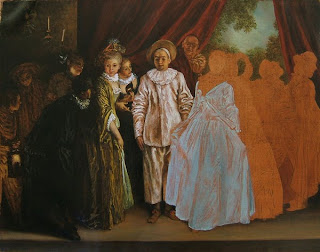brooch Dali d'or embraced by a serpent
After Dada, comes Surrealism - but can you follow after such amply spaced posts? Such a commotion at and around the 20th anniversary days of the death of Salvador Dali. A spate of films recently out or in the works show that thee controversial artist still fasinates: Little Ashes (Paul Morrison),
Dali and I: the Surreal Story (Andrew Niccol),
Dali (Philippe Mora), and leading them all with a film short in 2005,
The Death of Salvador Dali (Delaney Bishop). Hoaxter or genius, child-like prankster and swindler too - he is quoted as saying, “each morning after breakfast I like to start the day by earning $20,000.” Dismissing the scandals of his later life when he was said to make quick sketches or sign forgeries for quick cash, he was an extraordinary character. What does it matter when his whole life was spent to give us a jolt?His work and life were not about subtlety, he was quite the King of Camp, but both give issues to ponder. I'm convinced we should pick and choose in it at will.
The Persistence Of Memory
Dali's idea of melting clocks was first expressed in a 1931 painting. The idea supposedly came to him while watching a wheel of Camembert melt in the heat of the midday sun.
One of his emblems, it was later translated into brooch form.
The
Espace Dali in Montmartre is hosting
les bijoux en Dali d’Or, inspired by the luxury and extravagances of the Sun King. In minting his own coins, Dali sets his self-aggrandizing profile face to face with that of Louis XIV on his Louis d'Or .
The jewels exhibited were designed in the 60s and dedicated to his wife and muse, Gala.
All bear the profiles of artist or muse.
Dali d'or pendant
What's better than a Louis d'or? A Dali d'or of course, or a solid gold Dal 'or,
with effigies heads-or-tails of Dali and Gala in a flamboyant expression of love for his wife
...signed by the artist.
NARIQUE MENESES/REX FEATURES
Dali with Gala in 1964
Bejewelled Gala adorns Dali
A true love story, perversions and all.
Royal Heart 1953*
Gold, rubies, sapphires, emeralds, aquamarines, peridots, farnets, amethysts, diamonds and pearls
The ruby heart still pulsates with shimmering majesty.
Just a click to see it
beat.
Strange love and love of the strange coursed through his veins and were driving forces.
Tree of Life 1949*
Falsely classic and in his own image. A face peers out of the foliage reminiscent of a ancient wood spirit carving or one of Arcimboldo's personifications of the seasons. Lost souls and man faced by Nature might not be the basic premises of surrealism, but they are never too far off.
The Eye of Time 1949*
Signature in evidence. Doesn't blink ; he's watching to make sure you are looking.
from Dali's sets for Hitchcock's 1945 Spellbound
Something tells me that if possible, he's still watching.
What part does dream and play have in your Life and Work?
**













































.jpg)



 As for Maison Jansen, probably the first of interior design firm, it was such a large operation and lasted so long (1880-1989) that at any given moment there are furnishings to offer on the market. In passing, a design school now occupies Jansen's manufacturing sites.
As for Maison Jansen, probably the first of interior design firm, it was such a large operation and lasted so long (1880-1989) that at any given moment there are furnishings to offer on the market. In passing, a design school now occupies Jansen's manufacturing sites.

